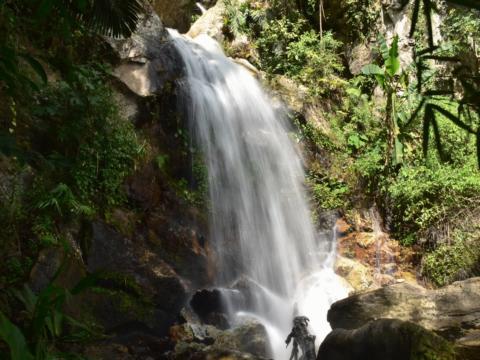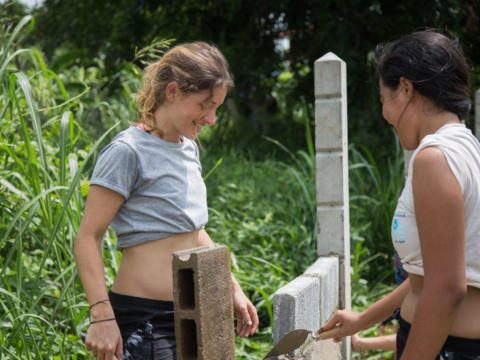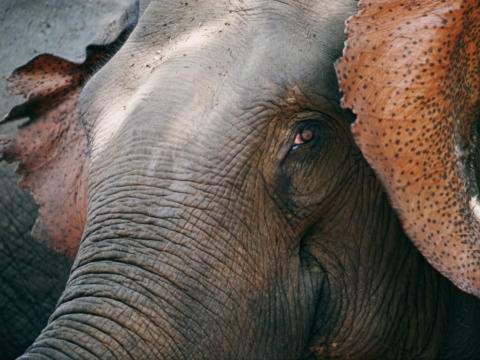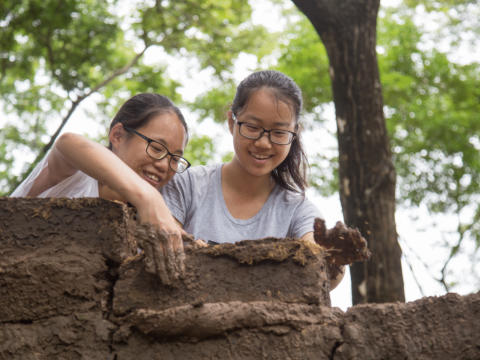Only 675€ per week!
Elephant Sanctuary
Kanchanaburi - Thailand
Get up close to elephants in a sanctuary where they freely roam. Wash them, prepare their food, bathe and swim with them!
This project takes care of rescued and sick elephants. You will enjoy washing and swimming with the elephants, whilst also preparing food and making sure that the elephants are living in a comfortable environment. Moreover, we will take you out to discover Kanchanaburi’s gorgeous nature.
Program Description
The project is based in Kanchanaburi, which manages a delicate balance between tradition and tourism. Its surrounding limestone hills create an unimaginably beautiful landscape enhanced by its numerous bamboo-style buildings, stunning meandering rivers and unique temple caves. Kanchanaburi is truly one of Thailand’s natural gems and the perfect place to indulge in nature and spend time with elephants in our project.
The project takes place in a sanctuary where old, sick, disabled, previously abused or illegally-owned elephants now call a home. Here, we work for the elephants, not the other way around. This means there will be no elephant riding in the program. However, you will get the chance to experience and bond with these gentle giants by swimming with them, bathing them and preparing their food, which typically comes in the form of Bana grass, sugarcane and banana plants.
The elephants freely roam around the sanctuary by day, and then are taken to the forest in the early evening.
You will be spending time alongside experienced mahouts, who invest their entire lives gaining an understanding of the elephants and how best to care for them. The sanctuary does receive one day and short stay visitors for respectful "Saddle Off" interactions with the elephants. Without this level of support the sanctuary would not be able to maintain these majestic animals who, whether young or old, were previously used in the captivity of hard labor (logging and farming) or entertainment labor (riding and shows). This could mean that you may see 40-50 persons on site working for the animals, preparing food, assisting with bathing and lovingly observing their actions.
Aims & Objectives
- Take care of relocated, injured, ill, previously abused or illegally owned elephants at the sanctuary
- Give you a unique, unforgettable experience in caring for elephants
- Assist the local sanctuary staff by providing an extra hand
Schedule
Monday
- After breakfast, depart to Kanchanaburi from Singburi and engage in an Introduction and Safety Rules lesson. This is followed by observing and feeding the elephants in the river
- Prepare sticky rice balls and feed them to the elephants
- Then after lunch, participate in bathing the elephants with mud inside the river!
- Nature Trekking – roughly half an hour of trekking around the elephant center
- Elephant bathing where you will get up and close washing an elephant with your hands!
- Elephant feeding
- Finish off the night with a nice Dinner!
Tuesday
- Breakfast in the morning followed by preparing food to feed the elephants such as grass and pineapple stalks
- Walk with the elephants, feed them and bathe them.
- Then after lunch, participate bathing the elephants with mud
- Elephant feeding
- Walk with the elephants
- Dinner
- Visit local market
Wednesday
- Sticky rice ball making and feeding the elephants
- Breakfast
- Go to Krasae Cave / The Death Railway and Collect Elephant dung
- Elephant bathing
- Dinner
Thursday
- Start off the morning with planting grass / bananas
- Breakfast
- Lunch
- Help caretakers in cleaning the area where the elephants are fed
- Nature Trekking – roughly half an hour of trekking around the center
- Dinner
- Cook rice in bamboo
Friday
- Breakfast
- Engage in some traditional grass cutting
- Elephant feeding and bathing
- Followed by traditional Thai cooking lessons
- Observation of elephants (grass eating)
- Lunch
- Elephant bed cleaning
- Campfire – bond with each other through engaging in a well-lit campfire
Saturday
- Breakfast
- Depart from the elephant sanctuary, taken to Kanchanaburi bus station if it’s the end of your program or back to Singburi for further programs out with the sanctuary
Note: This schedule can be changed and/or amended depending on weather conditions, local conditions and unforeseen circumstances.
Participant Criteria & Requirements
Standard Requirements
Minimum age: 18
Maximum age: –
Minimum English level: Basic
CRB required: On Signup
Passport copy required: No
Resume copy required: No
Required qualification: None
Additional Requirements
There are no further requirements for this program.
Additional Equipment
- Good walking shoes
- Clothes that you don’t mind getting dirty
Location
Boasting some of Thailand’s finest forests, a statement not to be taken lightly, Kanchanaburi is rapidly increasing as a popular tourist destination. Situated 130 km west of Bangkok, its central location makes it an ideal stop off point for those travelling through Thailand. Our location is based in a beautiful setting where you can see the elephants enjoying their natural habitat.
About the Accommodation
Accommodation is provided in a spacious house within the Sanctuary grounds. The rooms are simple, yet comfortable and appropriate for this setting.
Food Arrangements
A variety of Thai style dishes (vegetarian and fish) will be served. Mostly rice dishes will be provided in addition to fruits and vegetables, on a few occasions meat may be available too.
Facilities
The closest ATM is about 5 kilometers outside of the Elephant Camp. There is also a hospital, multiple convenience stores and also a pharmacy close-by for all your essential needs.
Activities & Events
No scheduled activities outside the program.
Sights & Surroundings
Due to its rural location, participants on this program normally stay on site at the park and enjoy their immediate surroundings. For those wanting to trek further afield, you might stumble across some waterfalls!
Transportation
From this location we provide free transport to your next program at the following location(s):
- Akha Village Chiang Rai
- All around Thailand
- Around Thailand
- Hua Hin
- Kaeng Krachan
- Mae Sot
- Singburi
- Suphan Buri
- Train Track Northern Thailand
- Trunk to the South
- Udon Thani
- Umphang
- Wang Nam Khiao
Quick Facts
Name: Kingdom of Thailand
Population: 67 million
Capital: Bangkok
Language: Thai
Currency: Baht (THB)
Time zone: ICT (UTC +7)
Country Information
From trekking in the beautiful mountains of the north to enjoying the glorious beaches in the south and experiencing the hustle and bustle of the metropolis that is Bangkok, Thailand is certainly not a country that lacks variety.
Whilst it really is at the heart of Southeast Asia, bordered by Myanmar, Laos, Cambodia and Malaysia, its cultural identity remains very unique. As the only country in Southeast Asia to avoid European powers, the Thai are proud to refer to themselves as ‘The Land of the Free’ and many tourists might also know it as ‘The Land of Smiles’ due to its friendly people.
Climate
The majority of the country is home to a tropical savanna climate which consists of wet and dry seasons of a roughly equal length. The climate can be divided into three distinct seasons:
- Dry season: November – end of February. During this period, precipitation is at its lowest but so are the temperatures. This said, ‘low temperatures’ are of course relative and the difference is not in fact very different at all in the South. It is only if you will be visiting the northern mountains that you might need to bring some warmer clothes as temperatures can fall as low as 5°C. This period is, not surprisingly, the most popular time to visit Thailand and tourism peaks around Christmas and New Year as well as Chinese New year. Flights and accommodation at this time can be more expensive.
- Hot: March to June. During this time Thailand reaches its hottest temperatures (as high as 50°C).
- Rainy: July – October. This is when the tropical monsoons begin to arrive, peaking in September. Although this is indeed rainy season, it doesn’t mean that it rains non-stop. Storms can clear up very quickly, but when it does rain, heavy flooding is not rare.
Culture
A significant feature of Thai culture is its primary religion: Buddhism. Theravada Buddhism is supported by the government and practiced by an estimated 95% of its population. Thailand not only boasts tens of thousands of beautiful temples, but you will notice that a lot of Thai people have miniature Spirit Houses on their front yards because they believe that the household spirits live in them and they make offerings to them to keep the spirits happy.
Another feature of Thai culture is the wai greeting, which is essentially a slight bow with palms pressed together in a prayer-like manner to show respect. This can be compared to the Indian namasté. Things to know about this:
- The higher the hands in relation to the face and the deeper the bow, the more respect is shown.
- It is made before formally entering/leaving a house
- It can also be made as a sign of gratitude or apology
- You do not make the greeting to those who are younger than you unless you are returning the wai.
- The gesture is normally accompanied with the phrase “sawadee (krap/ka)” (“krap” if you are male and “ka” if you are female)
- A corporate wai (made by cashiers etc) can be returned with a smile or a nod
The major festival in Thailand is Thai New Year, known as Songkran. It is celebrated on the 13th-14th April of every year. It is a festival that concludes the dry season and involves a lot of water throwing!
Gastronomy
Thai cuisine is very nutritious and alongside its plentiful use of rice, it generally contains fresh vegetables and white meats like chicken and fish. Thai people love spicy food but do not fear if you do not, just say ‘mai pet’ when you order. However, the flavors are not only about the spice, as many people believe. Thai food can be slightly salty, sour and/or sweet, so there really is something to suit everyone’s palate.
Transportation
Transport in Thailand is very varied and there isn’t one ‘main way’ to travel. Buses dominate long distance journeys. Travel in thailand is cheap and even domestic flights are a worthwhile consideration for long distance journeys, especially with the expansion of low-cost airlines.
Taxis, tuk-tuks and vans are also common modes of transport, but tourists must be wary about being overcharged. If in doubt, always ask that the taximeter be switched on to avoid overcharging.





